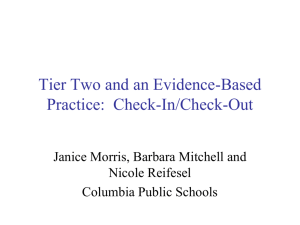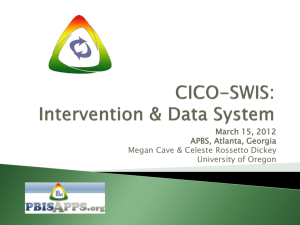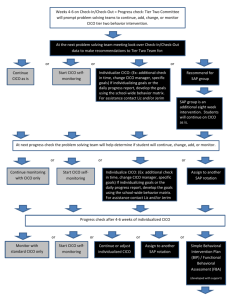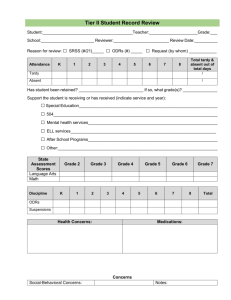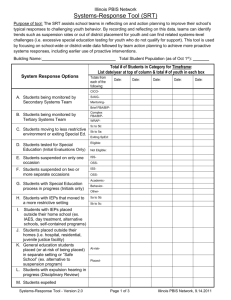Check in/ Check out: A Post-Hoc Evaluation of an Efficient,... Targeted Intervention for Reducing Problem Behaviors in Schools
advertisement
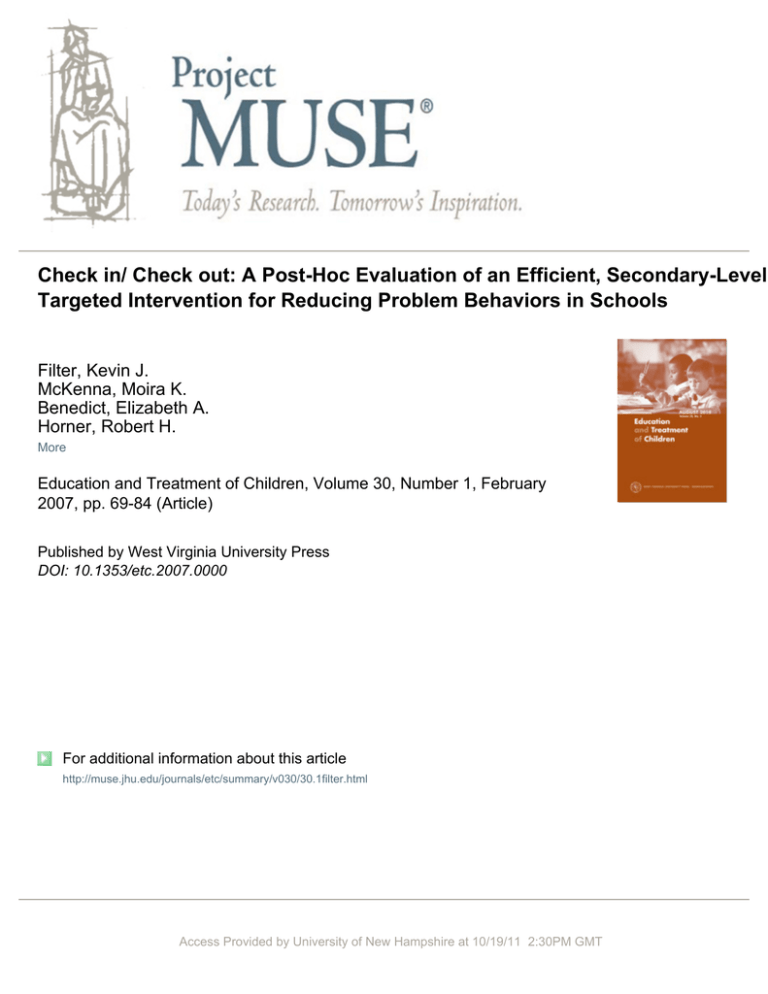
Check in/ Check out: A Post-Hoc Evaluation of an Efficient, Secondary-Level Targeted Intervention for Reducing Problem Behaviors in Schools Filter, Kevin J. McKenna, Moira K. Benedict, Elizabeth A. Horner, Robert H. More Education and Treatment of Children, Volume 30, Number 1, February 2007, pp. 69-84 (Article) Published by West Virginia University Press DOI: 10.1353/etc.2007.0000 For additional information about this article http://muse.jhu.edu/journals/etc/summary/v030/30.1filter.html Access Provided by University of New Hampshire at 10/19/11 2:30PM GMT EDUCATION AND TREATMENT OF CHILDREN Vol. 30, No. 1 2007 Check in/ Check out: A Post-Hoc Evaluation of an Efficient, Secondary-Level Targeted Intervention for Reducing Problem Behaviors in Schools Kevin J. Filter Minnesota State University, Mankato Moira K. McKenna, Elizabeth A. Benedict, Robert H. Horner, Anne W. Todd University of Oregon James Watson Eugene 4J School District Abstract The Check in/ Check out (CICO) program was developed as a secondarylevel, targeted behavioral intervention in a three-tier preventative model of behavior support and has received empirical support as an effective way to reduce problem behaviors (Hawken & Horner, 2003; March & Horner, 2002). The purpose of the present study was to evaluate, post-implementation, the fidelity of implementation and effectiveness of the CICO program to reduce problem behavior when program training and implementation was managed by typical district personnel. Results indicate that the critical components of the program were implemented with fidelity across three elementary schools and that the program was effective in reducing the number of office discipline referrals for students who entered the program. Further, the program was perceived as being effective and efficient by district personnel. It is argued that the CICO program should be considered a viable targeted behavioral intervention with students for whom primary-level preventative measures are insufficient. T he Check in/ Check out (CICO) program was developed as an efficient, secondary-level, targeted intervention for reducing problem behavior (Crone, Horner & Hawken, 2004). The structural goals of the approach are to (a) increase antecedent prompts for appropriate behavior, (b) increase contingent adult feedback, (c) enhance the daily structure for students throughout their school day, and (d) improve feedback to families about student behavior. Correspondence to Kevin J. Filter, Ph.D., Psychology Department AH23, Minnesota State University, Mankato, MN 56001; e-mail: kevin.filter@mnsu.edu. Pages 69-84 70 FILTER et al. The targeted intervention fits within school reform guidelines offered by Walker et al. (1996) to develop a three-tier model of prevention including: (1) primary prevention, school-wide discipline systems for all students, (2) secondary prevention, targeted interventions for students at-risk for more severe problem behavior, and (3) tertiary prevention, intensive, individual interventions for students with chronic problem behavior. Walker et al. noted several types of interventions that fit into the secondary, targeted level of support including social skills instruction, behavioral contracting, and at-risk counseling. It is generally recommended that secondary-level, targeted interventions be implemented with students who have two or more office discipline referrals but whose problem behaviors do not pose an immediate danger to self or others. More dangerous behaviors and behaviors that prove resistant to secondary interventions are best addressed with intensive tertiary-level interventions. The CICO program, also known as the Behavior Education Program, is a research-based intervention that addresses the secondary level of support for students who do not respond to primary prevention, but do not demonstrate dangerous pa�erns of problem behavior. The CICO program is built on a daily cycle in which a student checks in with a designated adult in the morning to develop behavioral goals, carries around a point card which provides numerous opportunities for adult behavioral feedback throughout the day, reviews behavior relative to goals with designated adult at the end of the day, and gives the point card to a parent at the end of the day, which the parent then signs and returns to the school. There is evidence that the CICO program is effective, and can be integrated with functional interventions (Hawken & Horner, 2003; March & Horner, 2002). In one study using a multiple baseline across students design (Hawken & Horner, 2003), the CICO program was implemented by teachers and school personnel in a rural middle school with four students with disruptive classroom behavior. The results demonstrated that teachers and school personnel implemented the intervention with fidelity, and that the systematic implementation of the CICO program was effective in reducing the overall level of students’ disruptive classroom behavior. In another experimental analysis, the CICO program was blended with function-based, individual interventions as a low cost, positive, and efficient intervention that was most effective for students whose disruptive classroom behavior was maintained by adult and/or peer a�ention (March & Horner, 2002). Similar reductions in problem behavior were reported by Bowers (2002) in a non-experimental evaluation with 11 junior high school students. Bowers also reported that 71 CICO PROGRAM reductions in problem behavior were associated with improved academic performance for students receiving support. Two recent studies have also investigated the effectiveness of CICO within a preventative model of behavior support. Fairbanks, Sugai, Guardino, and Lathrop (2005) implemented the CICO intervention with second grade students and found that four out of 10 students with significant behavior problems demonstrated significant improvement on the program. They then followed the remaining students and found that three more responded positively to functional tertiary behavior interventions. Todd, Kauffman, Meyer, and Horner (2005) conducted a multiple-baseline analysis of the effects of the program and found that the program led to a decrease in problem behavior for students in the program. They also found that teachers considered the program to be easy to implement and would recommend it to other schools. One notable feature common to the existing research studies in the CICO program that limits their generalizability to the natural school context is the fact that the researchers in the previous studies were actively involved in the training and on-going support of the program. Thus, the next logical step is to determine the program’s effectiveness and efficiency under natural conditions wherein training and on-going support were provided by district personnel. The purposes of the present study, therefore, were (a) to assess whether typical school personnel implemented the CICO procedures with fidelity using typical school and district resources and (b) to provide a quasiexperimental evaluation of the extent to which there were changes in the rate of problem behavior when students participated in the CICO program. Method Participants The faculty, administrators, staff, and students in three elementary schools (k-5 grades) in the Pacific Northwest participated in the study. The three schools were selected based on nomination by their district behavior support coordinator based on school personnel having completed a two-part, four-hour training in implementation of the CICO program and their willingness to complete the evaluation process. A summary of the demographic characteristics of the three schools is provided in Table 1. Schools participating in this study had already begun to implement school-wide positive behavior supports but varied in terms of the extent to which a broad range of supports was in place. 72 FILTER et al. Table 1 Demographic characteristics of schools participating in the study Number of students participating in evaluation Number of teachers, staff, and administrators participating in evaluation Enrollment Percent NonWhite K-5 435 24.55 49.89 12 7 K-5 321 18.15 32.4 5 4 K-5 251 15.57 29.48 2 6 School Grades School A School B School C Percent who qualify for free or reduced lunch Students participating in the evaluation were selected because they had been in the school for at least 6 weeks without behavior support during the 2002-03 academic year, were nominated by their faculty/staff to receive behavior support, had been participating in the CICO program for at least 6 weeks during the same year, and consented to participate. Each school had developed its own criteria for determining which students should be placed on the CICO program. However, in each case the decision was made by the schools’ behavior support team using office discipline referral data as an indicator of students’ response to primary-level interventions. All 19 students who met the above criteria were included in the study. Teachers, administrators, and staff from each school also participated by completing paper and pencil ratings for the program. Each school had 1 administrator participate. The evaluation included a total of 11 teachers and 3 classified staff. Measures Data were collected on the extent to which (a) the CICO program was implemented with fidelity, (b) the program was related to change in rate of formal office discipline referrals, and (c) the faculty/staff perceived the program as effective and efficient. Fidelity. To assess whether the school personnel implemented the CICO program with fidelity, the 4 to 7 teachers, staff, and/or administrators from each school who made up the student support CICO PROGRAM 73 team (a total of 17 individuals across the three schools) completed a 5-item implementation checklist based on similar instruments used by Hawken and Horner (2003) and March and Horner (2002). Each respondent circled “yes”, “no”, or “don’t know” for each item based on their experiences with program implementation. Participants were not providing responses that were associated with one particular student in the CICO program nor where they using permanent products to guide their reporting. Instead, they were reporting on their general experiences with the program at the school. The five items on the fidelity checklist assessed whether: (a) students checked in at the start of the school day, (b) students received feedback a�er designated time intervals throughout the day, (c) students checked in at the end of the day, (d) a family member reviewed the student’s daily report, and (e) data were gathered, graphed and used for decision-making. The fidelity measure was completed at each school during a regularly scheduled behavior support team meeting in January or February of the academic year, with one or two of the authors present. Office discipline referrals. Office discipline referrals (ODRs) were collected to compare the rates of problem behaviors before and during participation in the CICO program. All schools participating in the study maintained archival records of ODRs in the web-based SchoolWide Information System database (SWIS; May et al., 2000). ODRs were chosen as the outcome measure for problem behavior because they are readily available, represent agreed upon problem behaviors and definitions in the local context, and are sensitive measures of behavior change (Irvin, Tobin, Sprague, Sugai, & Vincent, 2004). Tobin, Lewis-Palmer, and Sugai (2002) assessed the reliability of SWIS ODRs by measuring the agreement between information entered into the SWIS system and the information contained on paper ODRs. They found an overall average agreement of 86.6% between the two and 95.9% agreement for the behavior information on the ODRs. Li�le other reliability evidence currently exists for ODRs as a measure of student behavior. Irvin et al. point out that the generation of ODRs represent the involvement of several individuals (i.e., teacher, student, and administrator). Thus, a portion of the measured behavior in ODRs likely reflects some idiosyncratic contributions of each individual. However, Irvin et al. further note that ODRs have been used successfully in numerous program evaluations and are generally the best available archival behavioral data in schools. School A maintained separate databases of major and minor ODRs. Therefore, the effects of the CICO program were analyzed separately for major and minor ODRs. Examples of major ODRs maintained in the SWIS database include defiance, aggression, and 74 FILTER et al. vandalism. Examples of minor ODRs include rule violation, minor inappropriate language, and failure to complete an assignment. Major ODRs were available for all 19 participants and minor ODR data were available for the 12 participants from School A. Several decision rules were used prior to collecting and analyzing ODR data. First, September ODRs were not included due to the array of start-up activities at the beginning of the school year. Second, when only a month was given for a start or stop date, rather than a specific day, then the start/stop dates were considered to be the 15th of the reported month. Third, students with no ODRs prior to January of the evaluation year were excluded from the analyses as they were presumed to not be full-year a�endees of the school and likely responded appropriately to the primary-level interventions in the school. Finally, although 2 of the students were put back on the program later in the year, ODR data were only used from the first off-on sequence to reduce serial dependency effects. Perceived effectiveness and efficiency. During the same regularly scheduled behavior support team meeting in which fidelity data were gathered, teachers, staff, and administrators also completed a measure of perceived effectiveness and efficiency of the CICO program. Respondents were instructed to use a Likert scale from 1 to 6 (poor to excellent, respectively) that most accurately reflected their opinions about the program as implemented in their school along several dimensions, including (a) ease of implementation, (b) time and effort required relative to other behavior interventions, (c) student progress, (d) level of change in behavior relative to time and effort involved, and (e) importance of observed changes in behavior. Design and Procedures A quasi-experimental design comparing student ODRs before and during participation in the CICO program was used to assess whether implementation of the program was associated with reductions in problem behavior. Schools participating in the study had been implementing the CICO program for at least 1 full year prior to the study following procedures described in Crone, Horner, and Hawken (2004). CICO program. Implementation of the CICO program required collaboration between the student, school personnel and families (Crone, Horner, & Hawken, 2004). The daily cycle included five steps. In Step One the student met a staff person for a morning “check-in.” During this check-in time, the staff person discussed the student’s behavior goals and point goals for the day and gave him/her a point card. Figure 1 is an example of a point card used in the CICO program. 75 CICO PROGRAM Student Point Card Name______________________ Day ________ Read Time Recess PE/ Music Writing Lunch Math Recess Block Goal #1 Respect Others Goal #2 Respect Property Goal #3 Work Hard 2 = Great Points 1 = Good but Received a Warning Today’s Today’s Goal Total Total Yes? Goal met! Possible goal not met today 0 = Required a Time Out Parent: Please sign card to indicate that you have seen this card. Parent Signature_________________ Date ____ Comments welcome on back Figure 1. Example of a student point card used in CICO program. Details of point card vary based on student schedules and unique behavior goals. The basic function of the card was to provide regular feedback to the student by giving teachers a place to rate behavior by points for each behavior goal during various times in the day. Step Two involved the student giving the point card to the teacher at the beginning of each class period. In the third step, the student obtained teacher feedback about his or her behavior on the point card at the end of each class period. Step Four was a meeting between a staff person and the student to “check-out” at the end of the school day. At this time, the staff person reviewed the student’s behavior performance throughout the day and discussed the student’s successes and difficulties, including problem-solving be�er behavior options for the next day. In this fourth step, the staff person also determined whether the point goal set at the beginning of the day was met. If the goals were met, then an agreed upon reward was provided. The fi�h and final step of the daily cycle involved having the students carry the point card home, obtaining an adult family member’s initials and returning the point card to school the next morning. The weekly cycle included the summarization of data by the CICO program coordinator with possible weekly review of individual student data by the behavior support team. The monthly cycle included a behavior support team meeting to review the percentage of 76 FILTER et al. points earned by each student on the program. The behavior support team used this information to make adjustments to support options or points required for the student to earn tangible reinforcement at the end of the school day. On a quarterly schedule, the behavior support team provided feedback to all school personnel, families, and students regarding the impact of the CICO program. In the present study, the training and on-going support for the program was provided by district and school-site personnel. To begin, the district positive behavior support coordinator, who had worked for the district as a teacher for 20 years and who served as a behavior support facilitator in a school for several years before becoming the district coordinator the year prior to this evaluation, provided two, 2-hour trainings with school teams so that they were familiar with the program and could begin to plan for its implementation in their schools. These trainings were provided 2 years before the present evaluation. A�er the initial training, schools managed the program with their on-site behavior support teams, which included representative staff and administrators from the school. The teams managed the data review process and supported the staff members who implemented the program. The schools involved in this evaluation were not approached about an evaluation of the program until a�er the program had been implemented. Therefore, the program was not implemented for research purposes, and evaluation of the program is most relevant to its use and effectiveness under natural school conditions. Analysis. Fidelity of implementation and perceived effectiveness and efficiency of the CICO program were analyzed using descriptive statistics. The effects of the program on student problem behavior were analyzed by comparing the student participants’ mean number of ODRs per week before and during participation in the program using a paired samples t-test. Results Fidelity of Implementation In total, 17 individuals completed the fidelity of implementation questionnaire. Eleven of the respondents were teachers, three were administrators, and three were classified staff. All respondents reported that their schools completed the morning check in and a�ernoon check out of students. Sixteen of 17 respondents reported that the students took the CICO card to each teacher in their daily schedule to obtain feedback. Therefore, the three initial components of the CICO program were in place in all three schools. Only 7 out of 17 respondents reported that a family member reliably initialed the cards each day. Fourteen of 17 respondents indicated that their schools used the 77 CICO PROGRAM ongoing results from the program to make student support decisions. In summary, all three schools reported that they were using the daily check in and check out components of the program, and were regularly using data from the program for decision-making. Only 41% of respondents indicated that the family feedback component was implemented. Table 2 presents the composite frequencies of response to Table 2 Composite Frequencies of Responses to Fidelity of Implementation Questions Question Yes No Don’t Know a Do students check in with a designated teacher/ staff in the morning? 17 0 0 b Do students take the CICO form to each teacher to obtain feedback? 16 1 0 c Do students check out with a designated teacher/ staff at the end of the day? 17 0 0 d Do parents initial that they reviewed the CICO form every day? 7 6 4 e Are ongoing results reviewed to make decisions for student supports? 14 2 1 the fidelity of implementation questions. Office Discipline Referrals Combined major and minor ODRs. When all ODRs were combined for the 12 participants for whom both results were available, a significant decrease in ODRs per week was detected when students were participating in the CICO program (M=0.59, SD=0.52) as compared to their ODRs before their participation in the program (M=0.90, SD=0.65), t(11) = 2.24, p = .05 (2-tailed). Thus, when students were participating in the program, they averaged one ODR every 8.47 days compared to an average of one ODR every 5.59 days when not participating in the program. Figure 2 is a graphical depiction of the effects of the program on ODRs. Eight of the 12 participants demonstrated a decrease in combined ODRs when participating in the program, while only one participant demonstrated an increase in combined ODRs. The other three students showed no ODRs before or during their participation in the program. Positive results, therefore, were found for 67% of the participants in the program. Three students demonstrated at least a 50% 78 FILTER et al. Combined 0.90 Office Discipline Referrals per Week 1.00 0.90 0.80 Minor 0.65 0.70 * Combined 0.59 * Minor 0.47 0.60 0.50 0.40 0.30 Major 0.22 0.20 Major 0.15 0.10 0.00 Before Participation During Participation N for major ODRs was 19. N for minor ODRs and combined major and minor ODRs was 12. * p < .05 Figure 2. Major, minor, and combined office discipline referrals per week for students before and during participation in CICO program. decrease in major ODRs between conditions. Although the CICO program produced significant effects on combined ODRs, the pa�ern of significance was different for major and minor ODRs, as reported below. It should be noted that since minor ODRs were not recorded and available for all schools and student participants, there are unequal N’s for major (N=19) and minor ODRs (N=12). Thus, the means for combined ODRs (N=12) is not equal to the sum of the means for major and minor ODRs. Major ODRs. Results indicate that students had fewer major ODRs per week when they were participating in the program (M=0.15, SD=0.20) than before participation in the program (M=0.22, SD=0.26). However, the difference was not statistically significant t(18) = 1.19, p = .25 (2-tailed). A total of 13 out of the 19 students showed a decrease in major ODRs when in the program. Two students showed an increase in major ODRs when in the program. Therefore, the program was associated with positive results for 68% of students and negative results for 12% of students, as measured by major ODRs. Six of the 13 students who demonstrated a decrease experienced at least a 50% decrease in major ODRs between conditions. 79 CICO PROGRAM Minor ODRs. Results indicate that students had statistically significantly fewer minor ODRs per week when they were participating in the program (M=0.47, SD=0.35) than before participating in the program (M=0.65, SD=0.45), t(11) = 2.38, p = .04 (2-tailed). A total of 8 out of the 12 students for whom minor ODR data were available showed a decrease in minor ODRs when in the program. Only one student showed an increase in minor ODRs when in the program. Therefore, the program was associated with positive results for 67% of students and negative results for 8% of students, as measured by minor ODRs. One of the eight students that demonstrated a decrease in minor ODRs experienced a 50% decrease between conditions. Perceived Effectiveness and Efficiency Table 3 presents respondents’ average Likert scale ratings of perceived effectiveness and efficiency of the CICO program. Composite mean ratings of perceived effectiveness and efficiency ranged from 4.19 to 5.06, with importance of observed behavior change receiving the highest rating. All items were rated as being 4.00 or above by all groups (teacher, administrators, and staff) with the exception of “ease of implementation”, which received a mean rating of 3.00 from the administrators (n=3). In summary, all composite mean ratings of effectiveness and efficiency of the program were on the positive side of the 6-point Likert-like scale, suggesting that the program was perceived by personnel in the school as being generally effective and efficient. Discussion Addressing problem behavior in the schools requires a systematic planning process to minimize expenditure of resources while maximizing levels of appropriate student behavior. It is an inefficient use of school resources, for example, to conduct thorough individualized evaluations of every student who fails to respond to primarylevel preventative measures in order to develop behavioral interventions. This is particularly true given (a) recent evidence indicating that 13% of students in elementary schools demonstrate between two and six ODRs per year despite the presence of primary-level preventative measures (Horner, Sugai, Todd, & Lewis-Palmer, 2005) and (b) evidence that standard package behavioral interventions like the CICO program can produce significant decreases in problem behavior for some students (Hawken & Horner, 2004). Therefore, interventions that are easy to administer, can be implemented within 72 hours, and are based on validated behavioral principles represent a viable initial alternative to individualized interventions in a preventative framework. 80 FILTER et al. Table 3 Means and standard deviations of responses from teachers, staff, and administrators to items in a perceived effectiveness and efficiency rating scale. Perceived Effectiveness and Efficiency Questions Mean Response (Standard Deviation) a How would you rate the ease with which the CICO program can be implemented? 4.19 (1.38) b Compared to other interventions, how would you rate the CICO program in terms of time and effort required for program implementation? 4.41 (1.06) c How would you rate student progress for those students participating in the CICO program? 4.50 (0.63) d How would you rate the change in student behavior as it relates to the time and effort that you put into the intervention? 4.63 (0.81) e How would you rate the importance of student behavior change in terms of the student’s ability to learn in a typical educational environment? 5.06 (0.97) Interventions that fit these criteria are referred to as secondary-level, targeted interventions in a three-tiered preventative model (Walker & Shinn, 2002). The CICO program was developed to fit these criteria. Thus, the CICO program, which is similar in design to some behavioral interventions commonly employed in schools, such as behavioral contracts and token economies (Miltenberger, 2004), offers potential as an efficient and structured option to address the behavioral needs of students who are resistant to primary-level interventions in a threetiered preventative model. The purpose of the present study, then, was to determine the extent to which the CICO program could be implemented with fidelity and lead to measurable improvements in behavior in natural contexts, thereby establishing its relevance to a three-tiered preventative model. The findings from this study suggest that the CICO program was implemented with fidelity by school-based professionals and that its implementation was associated with positive behavioral outcomes for two thirds of the students in the program. In the target schools, staff reported that four of the five components of the CICO program were consistently implemented. There was notable variability, however, CICO PROGRAM 81 in the extent to which parents were involved in the program. It was unclear why parents were not consistently signing the point cards of participants, but this may be an aspect of the program that requires more systematic training in the future in order to increase fidelity of implementation. When interpreting the effects of the program on student behavior, then, it is important to note that this feature of the program was not consistently implemented. The level of student problem behavior, as measured by minor and combined ODRs, was significantly lower when students were participating in the CICO program than before participation. Further, two-thirds of participants showed significant decreases across all ODRs when placed in the program. When considering that secondary-level interventions are not designed to improve the behavior of all students with whom they are applied (see Walker, 1996), the present finding strongly supports the contention that the CICO program is an effective secondary-level behavioral intervention for most students who do not respond to primary-level preventative measures. Those students who do not respond may be viewed as candidates for more detailed interventions based on functional behavioral assessment data (March & Horner, 2002; Fairbanks et al., 2005). Further support for the effectiveness of the CICO program came from the teachers’, staff, and administrators’ responses to questions regarding their perceptions of the program’s effectiveness. All ratings of perceived effectiveness across all dimensions of effectiveness were between 4.19 and 5.06 on a 1-to-6 scale where 1 represented “poor” and 6 represented “excellent”, thereby indicating that school staff perceived the program to be effective. Thus, support for effectiveness of the program was documented via objective measures and subjective measures in the natural context. As with all studies, particularly program evaluations conducted in the natural context, the present study had several limitations. First, the research methods used in this study were descriptive for fidelity and perceived effectiveness and quasi-experimental for objective effectiveness. Since the design did not control for all extraneous variables, it is impossible to eliminate alternative explanations for the measured effects. A more appropriate interpretation of the effects of the program, therefore, is that the program was associated with positive outcomes for problem behavior but may, or may not, have caused decreases in problem behavior. A second limitation of the study is the small sample size. This study included only 19 students in three schools. Therefore, external validity is limited. It should also be noted that the measured ODR outcomes may have been influenced by the decision rules reported for ODR data. For example, the decision to 82 FILTER et al. exclude all ODR data collected in September may have reduced the mean ODRs reported before participation in the program, potentially reducing the magnitude of the program effects. Also, it is unclear whether the decision to select the 15th of the month as the program start and stop date for all students for whom day-of-the-month data was missing may have increased or decreased measured mean ODRs before or during participation in the program. Some measures employed in this evaluation should be interpreted with caution. First, although Irvin et al. (2004) make a compelling argument for the validity of ODR data in program evaluation, their psychometric properties have not been clearly established at this time. This has been the source of some controversy in the field of behavior support. Since no analysis was conducted of the reliability or validity of ODRs in the present evaluation, interpretation of the effects of the program on problem behavior should be made cautiously. Also, fidelity ratings were provided post-hoc based on memory. The respondents did not actually have behavior cards in front of them. Thus, fidelity ratings are subject to memory biases and should be treated only as a general indicator of the schools’ implementation of the program. There are several important questions to be answered in future research regarding the CICO program. First, it will be important to conduct more research in order to improve prediction regarding which students are most likely to respond positively or negatively to the program. March and Horner (2002) suggested that the program is most likely to be effective with students whose problem behaviors are maintained by a�ention. Thus, future research should include comparative analyses of the function of the problem behaviors for students who respond to the program and those who do not. ODR data may be an appropriate source for this information provided it includes information about staff members’ perceptions of the controlling functions for the problem behavior. Another important future direction for research into the CICO program and other similar secondary-level interventions is to evaluate its impact on overall school discipline. Since the purpose of the secondary-level, targeted intervention in a three-tiered preventative model is to quickly remediate problems while they are still emerging, thereby reducing the number of students with problem behavior in the school (Sugai, Horner, & Gresham, 2002), it would be an important next step to conduct some pre-post comparisons on overall levels of school ODRs based on CICO implementation. As preventative models of behavior support continue to develop in the schools, teachers, administrators, and other professionals will need to be familiar with evidence-based interventions. The CICO program is quickly becoming such an intervention as it has been validated 83 CICO PROGRAM in controlled experiments (Hawken & Horner, 2004; March & Horner, 2002) and now under natural implementation conditions in the schools. While further research is still necessary, the CICO program should be considered an appropriate option for schools looking to implement secondary-level, targeted behavioral interventions with students for whom primary-level interventions were insufficient to produce important reductions in problem behavior. Acknowledgment Development of this paper was supported by a grant from the Office of Special Education Programs, with additional funding from the Safe and Drug Free Schools Program, U.S. Department of Education (H326S030002). Opinions expressed herein are those of the authors and do not necessarily reflect the position of the U.S. Department of Education, and such endorsements should not be inferred. References Bowers, C. (2002, October). CICO at Winston Campus. Paper presented at Office of Special Education Programs: Technical Assistance Center Forum, Chicago, IL. Crone, D.A., Horner, R.H., & Hawken, L. S. (2004). Responding to problem behavior in schools: The behavior education program. New York: Guilford Press. Fairbanks, S., Sugai, G., Guardino, D., & Lathrop, M. (In press). An evaluation of a collaborative social behavior response to intervention system of behavior support for second grade students. Exceptional Children. Hawken, L.H., & Horner, R.H. (2003). Evaluation of a targeted intervention within a schoolwide system of behavior support. Journal of Behavioral Education, 12 (3), 225-240. Horner, R.H., Sugai, G., Todd, A.W., & Lewis-Palmer, T. (2005). Schoolwide positive behavior support: An alternative approach to discipline in schools. In L. Bambara & L. Kern (Eds.) Individualized supports for students with problem behaviors: Designing positive behavior plans. New York: Guilford Press. Irvin, L. K., Tobin, T. J., Sprague, J. R. Sugai, G., & Vincent, C. G. (2004). Validity of office discipline referral measures as indices of school-wide behavioral status and effects of school-wide behavioral interventions. Journal of Positive Behavior Interventions, 6 (3), 131-147. 84 FILTER et al. March, R.E., & Horner, R.H. (2002). Feasibility and contribution of functional behavioral assessment in the schools. Journal of Emotional and Behavioral Disorders, 10 (3), 158-170. Miltenberger, R.G. (2004). Behavior Modification: Principles and Practices (3rd ed.). Belmont, CA: Wadsworth/Thomson Learning. May, S., Ard, W. III., Todd, A.W., Horner, R.H., Glasgow, A., Sugai, G., & Sprague, J.R. (2000). School-wide Information System. Educational and Community Supports, University of Oregon, Eugene, Oregon. Sugai, G., Horner, R. H., & Gresham, F. (2002). Behaviorally effective school environments. In M.R. Shinn, H.M. Walker, & G. Stoner (Eds.), Interventions for Academic and Behavior Problem II: Preventive and remedial approaches (pp. 315-350). Bethesda, MD: National Association of School Psychologists. Tobin, T. J., Lewis-Palmer, T., & Sugai, G. (2002). School-wide and individualized effective behavior support: An explanation and an example. The Behavior Analyst Today, 3 (1), 51-75. Todd, A., Kauffman, A., Meyer, G., & Horner, R. (In press). The effects of a targeted intervention to reduce problem behaviors: The check in check out program. Journal of Positive Behavior Interventions. Walker, H.M., Horner, R.H., Sugai, G., Bullis, M., Sprague, J.R., Bricker, D., & Kaufman, M. J. (1996). Integrated approaches to preventing antisocial behavior pa�erns among schoolage children and youth. Journal of Emotional and Behavioral Disorders, 4 (4), 194-209. Walker, H.M., & Shinn, M.R. (2002). Structuring school-based interventions to achieve integrated primary, secondary, and tertiary prevention goals for safe and effective schools. In M.R. Shinn, H.M. Walker, & G. Stoner (Eds.), Interventions for Academic and Behavior Problems II: Preventive and Remedial Approaches (pp. 125). Bethesda, MD: National Association of School Psychologists.
